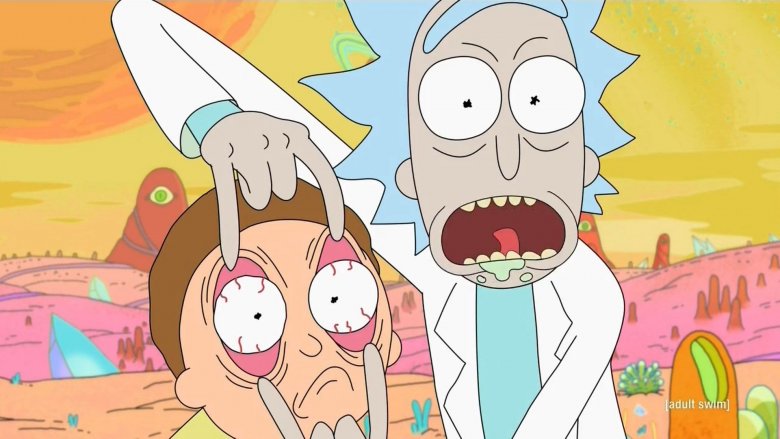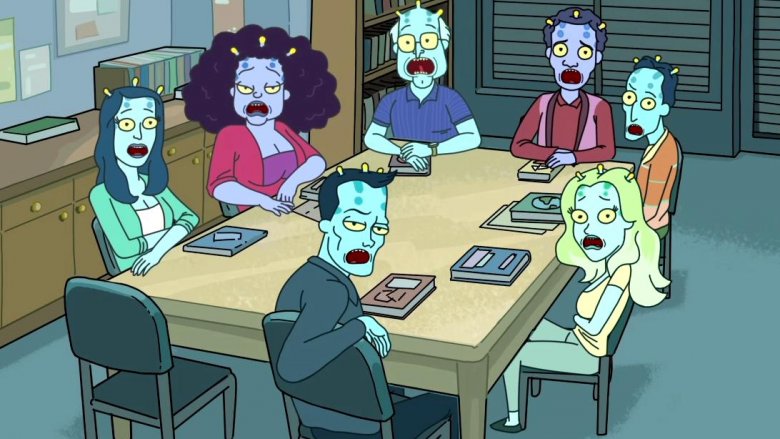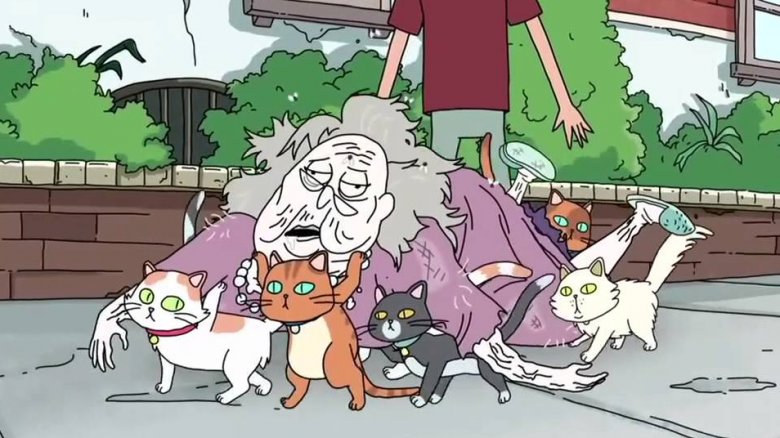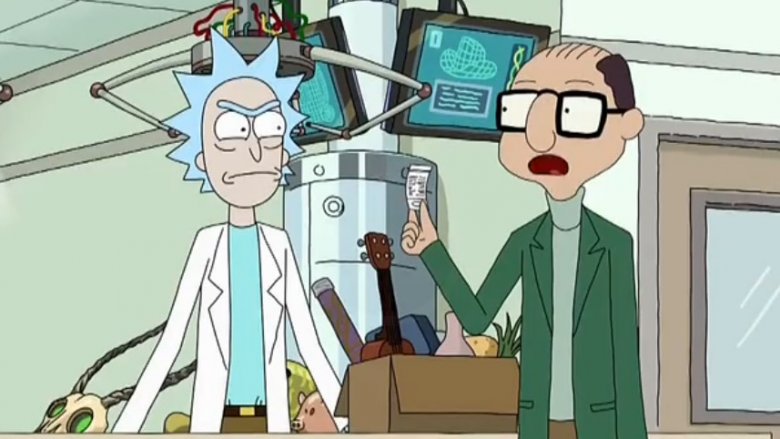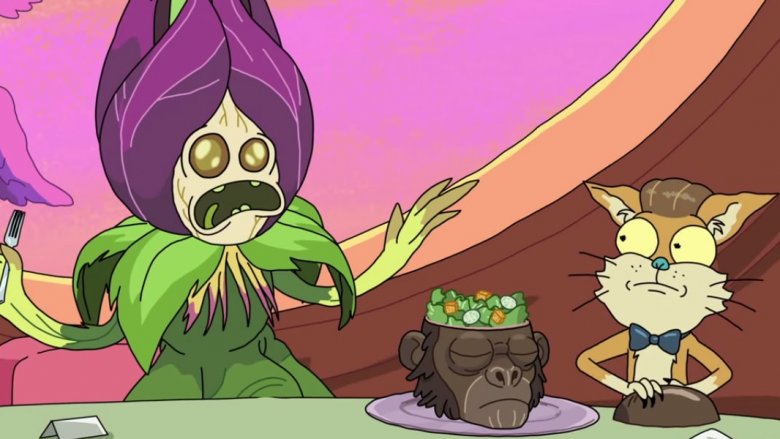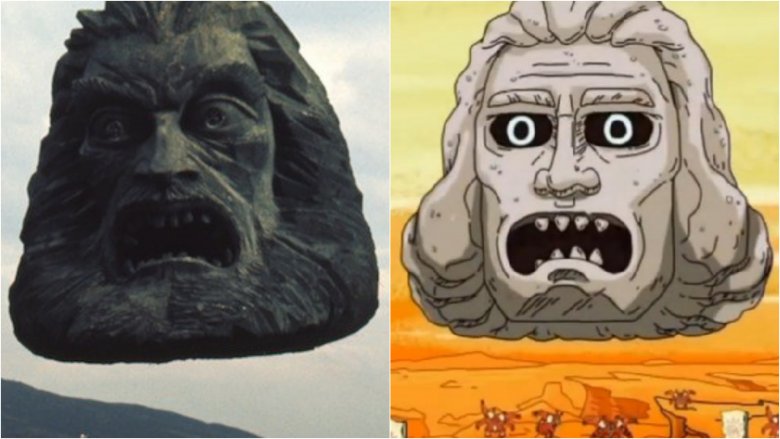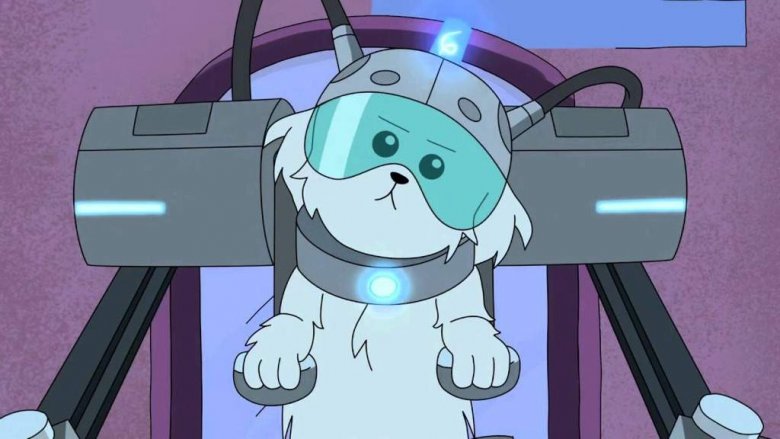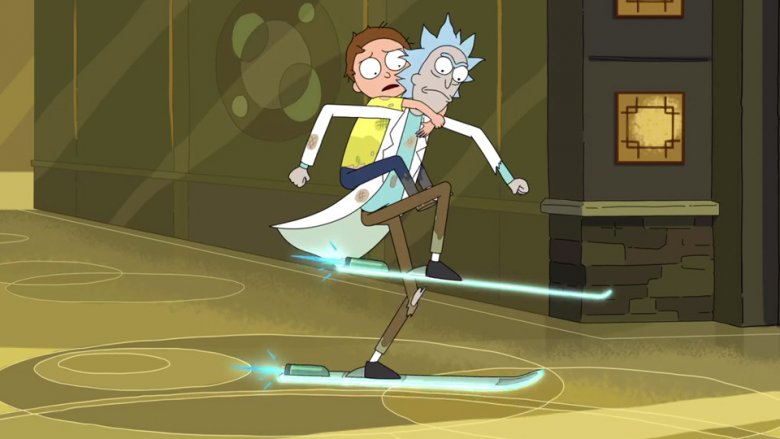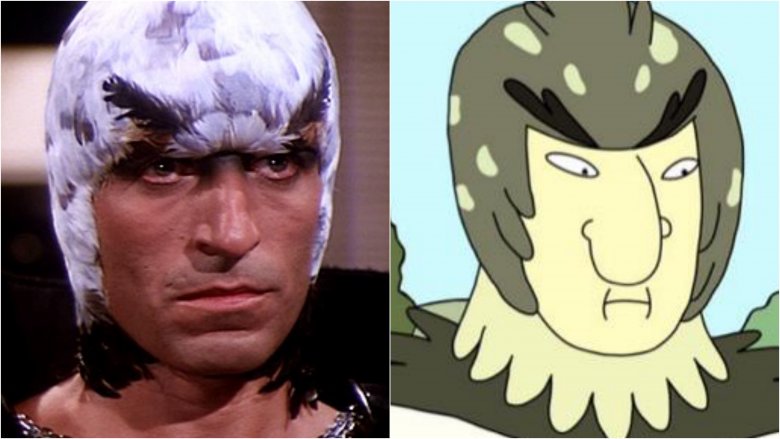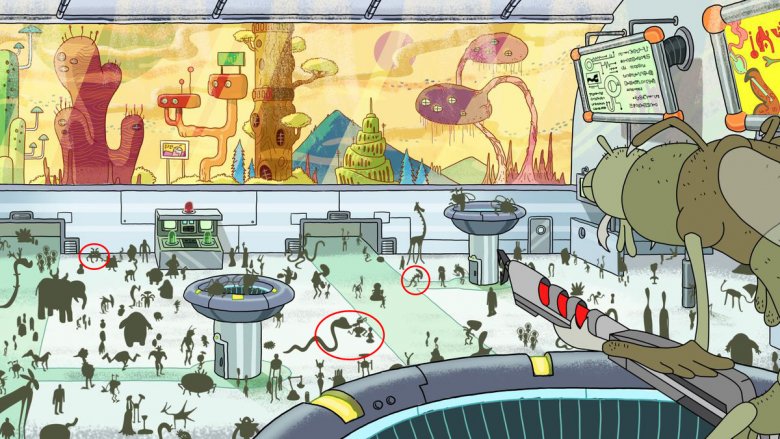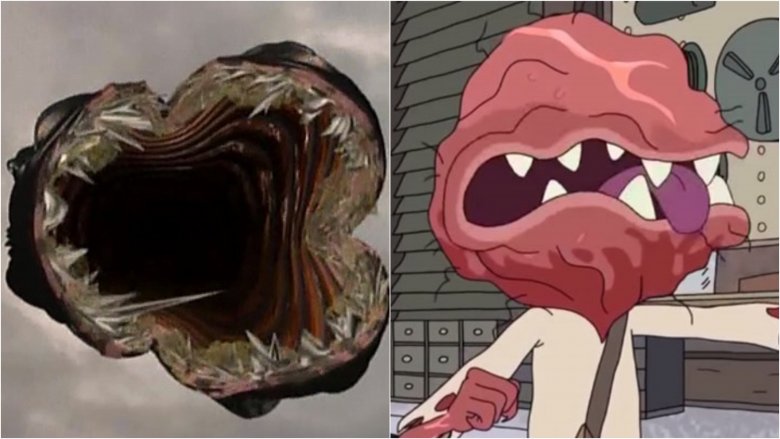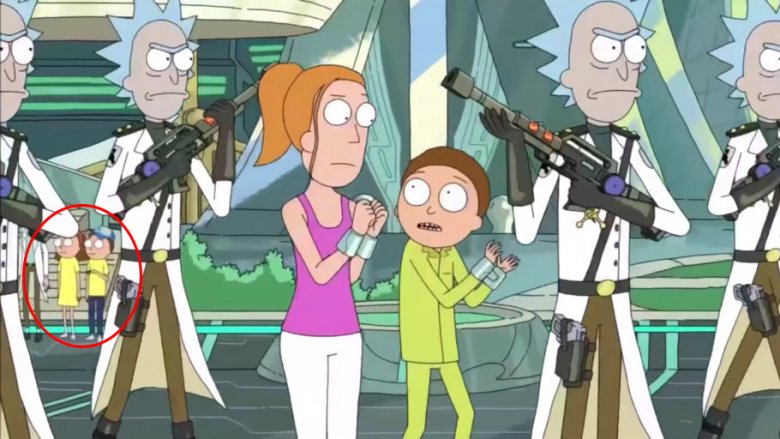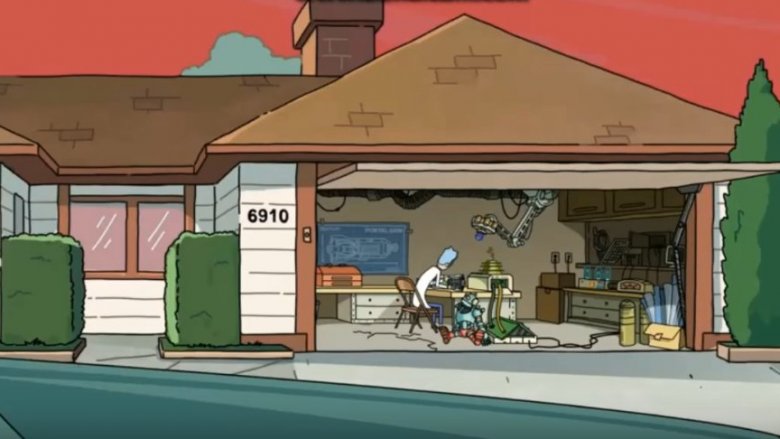References You May Have Missed In Rick And Morty
One of the worst-kept secrets in all of television history is the fact that Adult Swim's Rick and Morty is filled to the tippy-top with Easter eggs, tongue-in-cheek references, and oftentimes blindly obvious homages. There's an entire episode that spoofs Stephen King's Needful Things. The penultimate installment of season two takes root in the same narrative as The Purge film series. And remember the American Idol parody in "Get Schwifty"?
While co-creators Dan Harmon and Justin Roiland have imbued the sci-fi adventure comedy series with a ton of references to '80s-era film and television, literary allusions drawn from all across time, and many modern-day pop culture comments that are super easy to spot, the dynamic duo have also incorporated at least double that amount under the radar. We've dug deep into every episode, and returned with all the references in Rick and Morty that you may have missed the first time around.
Community
For diehard Rick and Morty fans or those who've been around the television-watching block a few times before, it's hardly a shock to know that series co-creator Dan Harmon was the brains behind another successful show: NBC's Community. Unfortunately, the series had a troubled six-year run. When Harmon was replaced as showrunner before the series' fourth season, Community lost its verve, and not even Harmon's return the following year could save it. NBC swung the axe on the series in May 2014, before Yahoo! Screen picked it up for a 13-episode sixth season. But sadly, the switch from traditional to digital broadcasting proved deadly for the show, and it fizzled out after just a season on the 'net.
In Rick and Morty, Harmon pokes some serious fun at himself and the downfall of Community, hitting the series' soft spots. In Season 2, Episode 3, "Auto Erotic Assimilation," Rick (voiced by Roiland) and his on-again/off-again collective hivemind lover Unity are watching television, with the events playing out on-screen controlled by Unity itself. A very intoxicated Rick tells Unity, "Now make them all make fun of the blonde one. Now make them all do it on the table. Now cancel it! Now put it back on." The scene then shoots to an image of the Community crew, now in Rick and Morty-style alien animation, sitting at their iconic study table.
Weekend at Bernie's
The 1989 black comedy Weekend at Bernie's follows a pair of low-level suits working at a New York insurance company who, after a string of bizarre and genuinely chills-inducing events, end up spending their Labor Day weekend hauling around their dead boss, Bernie Lomax (Terry Kiser), and trying to convince everyone he's still alive.
Considering the fact that Harmon and Roiland love a bit of crude humor, it makes perfect sense that a Weekend at Bernie's reference would appear in Rick and Morty. However, it's one that isn't as obvious as lugging a corpse across a crowded beach. Amongst the bits in Season 1, Episode 8, "Rixty Minutes," there's a spoof trailer for a movie that centers around a dead elderly woman being held up by her cats, manually maneuvered like a puppet. Fittingly, the faux film is titled Last Will and Testa-meow: Weekend at Dead Cat Lady's House II. Let's just hope the reason behind her death wasn't the same as the one in Weekend at Bernie's.
Pet Sematary
The season one episode "Something Ricked This Way Comes" isn't shy about its sources of inspiration. From its title—a reference to Ray Bradbury's 1962 dark fantasy novel Something Wicked This Way Comes—to its plot that borrows character names, motivations, and settings from Stephen King's classic horror book Needful Things, the second-to-last episode of Rick and Morty's first season is a reference-lover's biggest dream. And it's only made more wonderful when you discover a hidden mention tucked inside a smaller scene.
After Rick turns his curse-lifting shop into a fully operating business, but just before he "gets bored" of the whole scheme and calls it quits, a man walks into Curse Purge Plus! across from Mr. Needful's store Needful Things. He tells Rick he's there to "pick up his undead cat and son." While the quip may just seem like typical Rick and Morty irreverence, it's actually a subtle reference to Stephen King's 1983 horror novel and its subsequent film adaptation Pet Sematary, which follows the well-to-do Creed family who are plagued by back-to-back tragedies: the accidental deaths of their cat and their two-year-old son Gage, both of whom are buried in the "pet sematary" near their Maine home, and disturbingly come back to life as demonic shadows determined to kill.
Indiana Jones and the Temple of Doom
Best known for its thrilling action sequences and, of course, the dashing Harrison Ford as the titular archeology professor turned adventurer, the 1984 film Indiana Jones and the Temple of Doom also gained a reputation for its gut-twirling dinner scene that involved chomping on bugs, slurping up baby snakes like spaghetti, and guzzling down eyeball soup by the bowlful. The shining entree in the yuck-fest, however, was a heaping mound of monkey brains—served in a severed monkey head for that additional gross-out factor.
A similar course is dished up in the season two finale of Rick and Morty, which centers around the wedding of Birdperson (Harmon) and Tammy Gueterman (Cassie Steele). Watch carefully during the reception montage and you'll see Squanchy (Tom Kenny) serving a "salad person" a bushel of lettuce, cucumbers, and carrots in a severed monkey head. Though no brains were involved, the dramatic effect is exactly the same as that seen in the '80s flick, making for a perfect (and quite sneaky) Indiana Jones reference.
Zardoz
Featuring a robotic sex doll, Morty's newfound fatherhood, a half-demon, half-human baby that reaches adulthood by sundown, and a planet filled with barbaric men who spend their days beating the living daylights out of each other, "Raising Gazorpazorp" will likely go down in Rick and Morty history as one of the strangest episodes the series has ever put forth. With all its uniqueness, you'd be justified to think the episode was relatively reference-free, save for the hilarious Footloose tribute that sees Morty Jr. busting an angsty move in an abandoned warehouse and the Raising Arizona nod in the title. However, you'd ultimately be wrong, as there's a sly movie mention hidden in the middle of all the craziness.
When Rick and Summer (voiced by Spencer Grammer) pay a visit to Gazorpazorp in the Andromeda system, the home planet of sex doll (whom Morty creepy-affectionately named Gwendoline), they see a giant floating head fly in to drop down more artificially crafted women used for procreation. The transient body part looks almost identical to the one seen in the 1974 sci-fi cult film Zardoz, a flick co-creator Harmon "assigned" his Harmontown podcast listeners to watch back in April 2013.
Animal Farm
George Orwell's Animal Farm gets a few carefully crafted references throughout the "Lawnmower Dog" episode of Rick and Morty, which sees the family's lily-white pet pup gain sentience, speech, and a newly fostered drive to take down all of humanity. Snuffles uses his powers to construct a full body suit, express just how angry he is about the way dogs have grown from wild beasts to humans' subservient playthings, and gather up a mutt-ley crew of fellow pups to rule over the Smith family—a progression of events that loosely mimics what's seen in Orwell's allegorical novella.
But that's just surface-level stuff; there's something even sneakier hidden in the best of places: a joke. In a scene where Snuffles, the dastardly dog in question, is at peak of his peril-doling reign, he insists that Summer call him Snowball. A funny bit in itself, as Snowball is no less domineering and powerful a name than Snuffles, the renaming moment is actually a direct nudge at Orwell's work. A main character in Animal Farm is named Snowball.
The link is tripled up when realizing that Snowball was voiced by Kelsey Grammer, the father of Spencer Grammer who lends her pipes to Summer in Rick and Morty, in the 1999 film adaptation of Animal Farm.
Inspector Gadget
Ask any child of the '80s or '90s to finish the sentence that begins with "Go, go..." and they'll likely answer "Power Rangers" or rattle off a list of Inspector Gadget gizmos. For Rick and Morty's part, it went with the latter in the season two episode "The Ricks Must Be Crazy." As Rick and Morty attempt to escape from the layered-up multiverses running inside Rick's car battery, Rick calls on his special shoes to unstick them from the jam they're in. "Go, go Sanchez ski shoes," he shouts, a wink at the strong but slightly dim-witted cyborg police inspector famous for his blunders. Thankfully, Rick's mechanic goes off without a trademark Inspector Gadget hitch, and the two rocket up several flights of stairs to safety.
Buck Rogers in the 25th Century
There are about a thousand reasons why Birdperson is such a cherished Rick and Morty character, but we venture to say it's his eccentric origins, monotone voice that delivers deadpan tales of violence and indiscretion, genuine vulnerability, and feather-ful design that has made him so magnetic. But could it also be familiarity that has pulled viewers into Birdperson's irresistibly odd charms?
One fan theory suggests that Birdperson on the whole is a reference to Buck Rogers in the 25th Century, a sci-fi adventure series that ran from 1979 to 1981. Based on the fictional space opera character Buck Rogers, created by Philip Francis Nowlan in the novella Armageddon 2419 A.D, Buck Rogers in the 25th Century had no shortage of interesting characters, but it was the alien named Hawk who really stood out. Hawk, played by Murder She Wrote alum Thom Christopher, was a half-man, half-bird warrior who represented the last of a dying breed of bird people—a background Birdperson himself possesses.
Beyond the feathery founding myth, Hawk and Birdperson are seriously similar in aesthetic make-up, sharing the same half-bird face and stern resting expression. Perhaps Birdperson's grandfather was Hawk? Or maybe Birdperson's avian ancestors were live-action in another dimension. One thing's for certain: we wouldn't put it past the Rick and Morty creatives to weave a web as weird as one that links the series to Buck Rogers in the 25th Century through concrete (but somewhat convoluted) familial ties.
Mystery Science Theater 3000, Alien, and Space Invaders
These mentions prove that Rick and Morty has been riding the reference train from the get-go. A scene from the very first episode of the series features a shot a ton of mysterious interplanetary creatures. Pause the pilot for just a moment to get an up-close-and-personal look at the visually complex sequence, and you'll notice that a number of the silhouettes shown are actually classic pop culture figures.
Near the center of the frame, adjacent to the light green walkway, three creatures look exactly like the wisecracking robots Tom Servo, Crow T. Robot, and Gypsy from the sci-fi comedy series Mystery Science Theater 3000. A few inches back on the opposite side, there's a shadow that resembles the terrifying Xenomorph from the Alien film franchise. Way over to the left-hand side of the screen, another appears to be a carbon copy of the blippy alien figure from the 1978 Tomohiro Nishikado-created arcade game Space Invaders.
The Langoliers
The second season premiere, "A Rickle in Time," gifted Rick and Morty enthusiasts with yet another kooky character: the Fourth-Dimensional Testicle Monster, voiced by funnyman Keegan Michael Key. An enforcer of the laws of time, the saggy-skinned, eye-less creature explains that Rick, Morty, and Summer must suffer the consequences of their messing with time and space. He sentences them to an eternity spent shackled in Time Prison. Though the trickster trio evade the time cop's clutches, his presence still lingered in viewers' minds long after the episode credits rolled. Where have we seen such a creature before?
The answer lies in good ol' Stephen King—his novel turned mini-series The Langoliers, to be exact. From an aesthetic standpoint, the Fourth-Dimensional Testicle Monster is a spitting image of the terrifying Langolier creatures seen in the 1995 mini-series. Both have wide, toothy mouths that occupy the majority of their facial planes; neither have eyes; and their skin is the same dark red-colored, wrinkly texture across the span of their bodies (which is, for the Langoliers, just a head). The reference is taken one step further when you realize that King's Langoliers literally devour time, sustaining themselves on the universe that's left behind when time passes, and that Rick and Morty's Fourth-Dimensional Testicle Monster exists an hour "behind" the present, similarly munching up the past as time goes on.
Gravity Falls
If you didn't have your peepers peeled to the same level of intense wide-eyed-ness as Morty had his in the pilot episode, you may have missed a few underhanded Gravity Falls nods. Look closely during the scene in Season 1, Episode 10, "Close Rick-counters of the Rick Kind" where Rick tries to dodge the Council of Ricks, and you'll see a pen, notepad, and mug emerge from a portal. These are exact same items Gravity Falls character Stan drops down a Universe Portal in the ending credits gag of Gravity Falls' "Society of the Blind Eye" episode.
Even better than that cheeky reference, in the season three premiere "The Rickshank Rickdemption," Morty is seen holding what appears to be Journal 3 from Gravity Falls as he walks through the Citadel of Ricks, a holding station for the Ricks and Mortys of multiple alternate dimensions that offer protection from the Galactic Federation. With so many off-kilter versions of the famed duo in sight, you may not have spotted a set of Morty twins in the background. In a blink-and-you'll-miss-it moment, you can see two versions of Morty—one male and one female—that look like Gravity Falls main characters Dipper and Mabel Pines. The boy twin is wearing Dipper's Pine Tree hat, and the girl has on Mabel's snazzy headband and sports her signature hairstyle.
Breaking Bad
The third season premiere "The Rickshank Rickdemption" nearly brought viewers to tears as Rick recounted his origin story, twisting a knife into every fan's heart. Granted, it wound up being a total fluke, but the sentiment still remained. And what made the moment even more special was the backstairs allusion to one incredibly acclaimed neo-western crime series.
The home seen in Rick's fake origin story is the same layout as Walter White's house in Breaking Bad—even down to the nitty-gritty details like plants that line the pathway to the front door and the location of the house number on the garage wall. The only difference is that Heisenberg was laundering the money he nabbed from selling top-quality crystal meth in his garage, and Rick was more focused on cracking the code to building a time portal. At least we can hope that's what he was doing.
